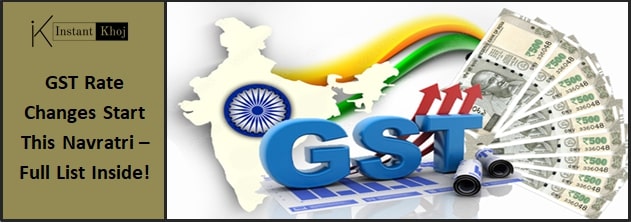The GST Council, headed by Finance Minister Nirmala Sitharaman, has announced a sweeping reform of India’s Goods and Services Tax (GST) structure—one of the most significant overhauls in its eight-year history. The changes simplify the tax structure into two main slabs of 5% and 18%, while introducing a new 40% slab for luxury and sin goods. These revisions come into effect on September 22, 2025, coinciding with the start of the Navratri festival.
Quick Highlights – New GST Rates 2025
| Topic | Details |
|---|---|
| Effective Date | September 22, 2025 (Navratri begins) |
| New Main Tax Slabs | 5% and 18% |
| New High-End Slab | 40% (for super luxury and sin goods) |
| Essentials Tax Changes | Many daily-use items brought down to 5% or nil |
| Luxury & Sin Goods | Taxed at 40%, includes tobacco, sugary drinks, high-end vehicles |
| Aim of Reform | Simplify GST, reduce inflation, spur consumption, ease tax compliance |
| Revenue Impact | Estimated ₹48,000 crore loss, much lower than earlier projections |
Why These GST Reforms Matter
India’s previous GST framework had four tax slabs—5%, 12%, 18%, and 28%—leading to complexity in rates and widespread criticism over classification issues. The new structure condenses this to just two general slabs (5% and 18%) and reserves the 40% slab for “sin” and luxury goods. This is expected to:
-
Lower rates on essentials and staples, easing the cost burden on households.
-
Reduce inflation by up to 1.1 percentage points according to economic forecasts.
-
Simplify compliance and classification, benefiting businesses and regulatory clarity.
-
Target luxury/spoiler goods via higher tax, balancing revenue loss with fiscal needs.
What’s Cheaper: Key Items in 5% or Nil Slab
The new GST structure significantly lowers tax on many common items:
-
Food staples: UHT milk and paneer become tax-exempt (nil), while butter, cheese, dried fruits, chapatis, parathas move to 5%.
-
Packaged snacks and beverages: Namkeen, pasta, noodles, butter, chocolates, and sauces drop to 5%.
-
Healthcare & medicines: Over 33 life-saving medicines are now tax-free. Spectacles and goggles are down to 5%.
-
Insurance: Individual life and health insurance products are now exempted.
-
Vehicle & appliances: Cement, TVs, ACs, dishwashers, refrigerators now attract only 18% GST (down from 28%).
-
Electric vehicles: Continue to enjoy a concessional 5% rate to encourage adoption.
What Costs More: Luxury & “Sin” Goods Now at 40%
A new 40% GST slab has been created for high-end goods and harmful items:
-
Sin goods: Pan masala, tobacco products, and sugary carbonated beverages.
-
Luxury vehicles: High-end cars (engine >1500cc), motorcycles above 350cc, yachts, private jets and helicopters.
Until compensation cess debts are cleared, certain sin goods remain at their existing rates.
Timeline & Economic Impact
-
Announcement Date: Early September 2025, GST Council meeting.
-
Implementation: Effective from September 22, 2025—start of Navratri.
-
Estimated Revenue Loss: ₹48,000 crore (~$5.5 billion), lower than early forecasts.
-
Inflation Impact: Expected reduction by up to 1.1 percentage points.
FAQs – New GST Rates 2025
Q1. When do the new GST rates come into effect?
A: From September 22, 2025, coinciding with the start of Navratri.
Q2. What are the new GST slabs?
A: Two new general rates—5% and 18%—plus a 40% slab for sin and luxury goods.
Q3. Which items are now cheaper?
A: Essentials like food staples, medicines, insurance, cement, EVs, and electronics now cost less due to lower GST.
Q4. What falls under the highest GST slab?
A: Items like cigarettes, pan masala, sugary drinks, luxury vehicles, yachts, and aircraft now carry a 40% GST.
Q5. Why were these changes made?
A: To simplify a complex tax structure, make goods more affordable, and stabilize consumer sentiment while maintaining fiscal prudence.
Final Words: What’s Next for Consumers & Businesses
The introduction of GST 2.0 marks a major tax reform that promises relief for households and clarity for businesses. With essentials becoming cheaper and luxury goods taxed higher, the balance aims to bolster consumption while ensuring equity in taxation.
If you’re a consumer—expect savings. Businesses—prepare to adjust pricing and compliance. Tax professionals—update your advisory with these slab changes. The new policy ushers in an era of simpler, fairer GST.
Read more articles like this — Click here to explore now





One thought on “GST Rate Changes Start This Navratri – Full List Inside!”